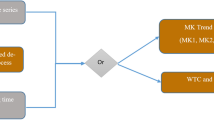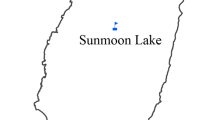Abstract
Synthetic aperture radar interferometry (InSAR) has proven to be a powerful tool for monitoring landslide movements with a wide spatial and temporal coverage. Interpreting landslide displacement time-series derived from InSAR techniques is a major challenge for understanding relationships between triggering factors and slope displacements. In this study, we propose the use of various wavelet tools, namely, continuous wavelet transform (CWT), cross wavelet transform (XWT) and wavelet coherence (WTC) for interpreting InSAR time-series information for a landslide. CWT enables time-series records to be analysed in time-frequency space, with the aim of identifying localized intermittent periodicities. Similarly, XWT and WTC help identify the common power and relative phase between two time-series records in time-frequency space, respectively. Statistically significant coherence and confidence levels against red noise (also known as brown noise or random walk noise) can be calculated. Taking the Huangtupo landslide (China) as an example, we demonstrate the capabilities of these tools for interpreting InSAR time-series information. The results show the Huangtupo slope is affected by an annual displacement periodicity controlled by rainfall and reservoir water level. Reservoir water level, which is completely regulated by the dam activity, is mainly in ‘anti-phase’ with natural rainfall, due to flood control in the Three Gorges Project. The seasonal displacements of the Huangtupo landslide is found to be ‘in-phase’ with respect to reservoir water level and the rainfall towards the front edge of the slope and to rainfall at the higher rear of the slope away from the reservoir.









Similar content being viewed by others
References
Berardino P, Fornaro G, Lanari R, Sansosti E (2002) A new algorithm for surface deformation monitoring based on small baseline differential sar interferograms. IEEE Trans Geosci Remote Sens 40:2375–2383. doi:10.1109/tgrs.2002.803792
Bin W, Huiming T, Jiebin Z, Wei X, Jun L (2007) Deformation and failure mechanisms of reservoir landslide considering fluid–solid coupling effect. Chin J Rock Mech Eng 26:4484–4489
Bittelli M, Valentino R, Salvatorelli F, Rossi Pisa P (2012) Monitoring soil-water and displacement conditions leading to landslide occurrence in partially saturated clays. Geomorphology 173–174:161–173. doi:10.1016/j.geomorph.2012.06.006
Cascini L, Sorbino G, Cuomo S, Ferlisi S (2014) Seasonal effects of rainfall on the shallow pyroclastic deposits of the Campania region (southern Italy). Landslides 11:779–792. doi:10.1007/s10346-013-0395-3
Cazelles B, Chavez M, Berteaux D, Ménard F, Vik J, Jenouvrier S, Stenseth N (2008) Wavelet analysis of ecological time series. Oecologia 156:287–304. doi:10.1007/s00442-008-0993-2
Chai B, Yin K, Du J, Xiao L (2013) Correlation between incompetent beds and slope deformation at Badong town in the three Gorges reservoir, China. Environ Earth Sci 69:209–223. doi:10.1007/s12665-012-1948-9
Chen S, Chen G-J, Xu G-L (2008) Mechanism of geological processes of formation and deformation of the Huangtupo landslide. Earth Sci J Chin Univ Geosci 33:411
Cojean R, Caï Y (2011) Analysis and modeling of slope stability in the Three-Gorges dam reservoir (China)—the case of Huangtupo landslide. J Mount Sci 8:166–175. doi:10.1007/s11629-011-2100-0
Cruden DM, Varnes DJ (1996) Landslide types and processes. In: Turner AK, Schuster RL (eds) Landslides: investigation and mitigation (special report). National Research Council, Transportation and Research Board Special Report, Washington, DC, pp 36–75
Deng QL, Zhu ZY, Cui ZQ, Wang XP (2000) Mass rock creep and landsliding on the Huangtupo slope in the reservoir area of the three Gorges project, Yangtze river, China. Eng Geol 58:67–83
Du J, Yin K, Lacasse S (2013) Displacement prediction in Colluvial landslides, three Gorges reservoir, China. Landslides 10:203–218. doi:10.1007/s10346-012-0326-8
Fang Z, Hang D, Xinyi Z (2010) Rainfall regime in three Gorges area in China and the control factors. Int J Climatol 30:1396–1406. doi:10.1002/joc.1978
Gençay R, Selçuk F, Whitcher B (2001) Differentiating intraday seasonalities through wavelet multi-scaling. Physica A Stat Mech Appl 289:543–556. doi:10.1016/S0378-4371(00)00463-5
Grinsted A, Moore JC, Jevrejeva S (2004) Application of the cross wavelet transform and wavelet coherence to geophysical time series. Nonlin Proc Geophys 11:6
He K, Li X, Yan X, Guo D (2008) The landslides in the three Gorges reservoir region, China and the effects of water storage and rain on their stability. Environ Geol 55:55–63. doi:10.1007/s00254-007-0964-7
He K, Wang S, Du W, Wang S (2010) Dynamic features and effects of rainfall on landslides in the three gorges reservoir region, China: using the Xintan landslide and the large Huangya landslide as the examples. Environ Earth Sci 59:1267–1274. doi:10.1007/s12665-009-0114-5
Hooper A (2008) A multi-temporal insar method incorporating both persistent scatterer and small baseline approaches. Geophys Res Lett 35:1–5. doi:10.1029/2008gl034654
Hu X, Tang H, Li C, Sun R (2012a) Stability of huangtupo riverside slumping mass ii# under water level fluctuation of three Gorges reservoir. J Earth Sci 23:326–334. doi:10.1007/s12583-012-0259-0
Hu XL, Tang HM, Li CD, Sun RX (2012b) Stability of Huangtupo i# landslide under three gorges reservoir operation. Appl Mech Mater 170–173:8. doi:10.4028/www.scientific.net/AMM.170-173.1116
Jackson S, Sleigh A (2000) Resettlement for China’s three gorges dam: socio-economic impact and institutional tensions. Commun Post Commun Stud 33:223–241. doi:10.1016/s0967-067x(00)00005-2
Jiang W-P, Huang B-Z, Ouyang H (2007) The monitoring technological method of landslide in Huangtupo. Resour Environ Eng 21:575–578
Jiang J, Ehret D, Xiang W, Rohn J, Huang L, Yan S, Bi R (2011) Numerical simulation of Qiaotou landslide deformation caused by drawdown of the three Gorges reservoir, China. Environ Earth Sci 62:411–419. doi:10.1007/s12665-010-0536-0
Jiao Y-Y, Song L, Tang H-M, Li Y-A (2014) Material weakening of slip zone soils induced by water level fluctuation in the ancient landslides of three Gorges reservoir. Advan Mater Sci Eng 2014:9. doi:10.1155/2014/202340
Jin Y, Wen-xing J, Hu-feng Y and Jiu-long Z (2012) Dynamic variation rule of phreatic line in Huangtupo landslide in the three gorges reservoir area. Rock Soil Mech 33:853–858
Liu P, Li Z, Hoey T, Kincal C, Zhang J, Zeng Q, Muller J-P (2013) Using advanced insar time series techniques to monitor landslide movements in Badong of the three Gorges region, China. Int J Appl Earth Observ Geoinformat 21:253–264. doi:10.1016/j.jag.2011.10.010
NOC (2014) Crosswavelet and wavelet coherence. National Oceanography Center. Http://noc.Ac.Uk/using-science/crosswavelet-wavelet-coherence. Accessed 20 May 2015
Peng L, Xu S, Hou J, Peng J (2014) Quantitative risk analysis for landslides: the case of the three gorges area, China. Landslides. doi:10.1007/s10346-014-0518-5
Singleton A, Li Z, Hoey T, Muller JP (2014) Evaluating sub-pixel offset techniques as an alternative to dinsar for monitoring episodic landslide movements in vegetated terrain. Remote Sensing of Environment 147:133-144. doi:10.1016/j.rse.2014.03.003
Tang H, Hu X, Deng Q, Xiong C (2009) Research on the characteristics and slope deformation regularity of the Badong formation in the three Gorges reservoir area. In: Wang F, Li T (eds) Landslide disaster mitigation in three Gorges reservoir, China. Springer, Berlin, pp 87–113
Tang H, Li C, Hu X, Su A, Wang L, Wu Y, Criss R, Xiong C, Li Y (2014) Evolution characteristics of the Huangtupo landslide based on in situ tunneling and monitoring. Landslides. doi:10.1007/s10346-014-0500-2
Tomás R, Li Z, Liu P, Singleton A, Hoey T, Cheng X (2014) Spatiotemporal characteristics of the Huangtupo landslide in the three Gorges region (China) constrained by radar interferometry. Geophys J Int 197:213–232. doi:10.1093/gji/ggu017
Torrence C, Compo GP (1998) A practical guide to wavelet analysis. Bull Am Meteorol Soc 79:61–78. doi:10.1175/1520-0477(1998)079<0061:apgtwa>2.0.co;2
Tullos D (2009) Assessing the influence of environmental impact assessments on science and policy: an analysis of the three Gorges project. J Environ Manage 90(Supplement 3):S208–S223. doi:10.1016/j.jenvman.2008.07.031
Wang F-W, Zhang Y-M, Huo Z-T, Matsumoto T, Huang B-L (2004) The July 14, 2003 Qianjiangping landslide, three Gorges reservoir, China. Landslides 1:157–162. doi:10.1007/s10346-004-0020-6
Wang F, Zhang Y, Huo Z, Peng X, Araiba K, Wang G (2008) Movement of the Shuping landslide in the first four years after the initial impoundment of the three Gorges dam reservoir, China. Landslides 5:321–329. doi:10.1007/s10346-008-0128-1
Wang X, Chen Y, Song L, Chen X, Xie H, Liu L (2013) Analysis of lengths, water areas and volumes of the three Gorges reservoir at different water levels using landsat images and srtm dem data. Quater Int 304:115–125. doi:10.1016/j.quaint.2013.03.041
Wen B, Chen H (2007) Mineral compositions and elements concentrations as indicators for the role of groundwater in the development of landslide slip zones: a case study of large-scale landslides in the three Gorges area in China. Earth Sci Front 14:98–106. doi:10.1016/s1872-5791(08)60006-8
Xia M, Ren G, Ma X (2013) Deformation and mechanism of landslide influenced by the effects of reservoir water and rainfall, three gorges, China. Nat Hazard 68:467–482. doi:10.1007/s11069-013-0634-x
Xie L (2009) Complex geological characteristics and mechanism and control technical of landsliding of Huangtupo at three gorges reservoir. Dissertation, Wuhan University of Technology
Acknowledgments
R. Tomás was supported by the Generalitat Valenciana fellowship BEST-2011/225 and by the Ministry of Education, Culture and Sport trough the project PRX14/00100. Part of this work is also supported by the Spanish Ministry of Economy and Competitiveness and EU FEDER funds under project TEC2011-28201-C02-02, by the Natural Environmental Research Council (NERC) through the GAS and LICS projects (ref. NE/H001085/1 and NE/K010794/1, respectively) as well as the ESA-MOST DRAGON-3 projects (ref. 10607 and 10665). We thank JPL/Caltech for the use of ROI_PAC, TU-Delft for DORIS and Andy Hooper for StaMPS in our data processing and analysis. The authors also acknowledge A. Grindsted, J.C. Moore and S. Jevrejeva for the MatLab package for CWT, XWT and WTC analysis and two anonymous reviewers and F. Raspini (University of Florence) for their constructive suggestions and comments, which have been carefully incorporated into the revised manuscript.
Author information
Authors and Affiliations
Corresponding author
Rights and permissions
About this article
Cite this article
Tomás, R., Li, Z., Lopez-Sanchez, J.M. et al. Using wavelet tools to analyse seasonal variations from InSAR time-series data: a case study of the Huangtupo landslide. Landslides 13, 437–450 (2016). https://doi.org/10.1007/s10346-015-0589-y
Received:
Accepted:
Published:
Issue Date:
DOI: https://doi.org/10.1007/s10346-015-0589-y




